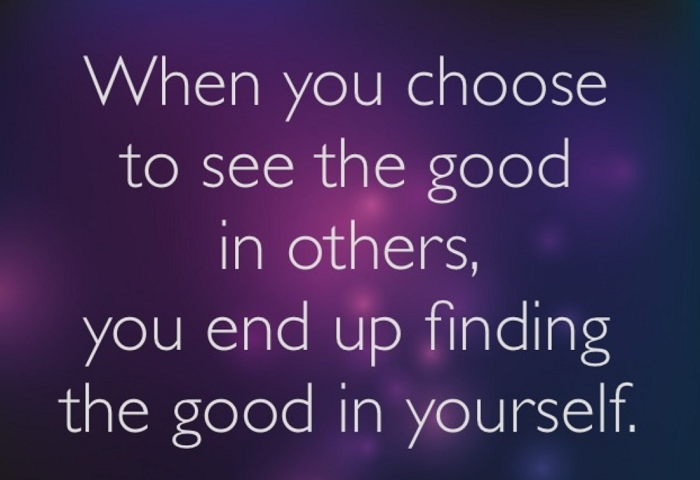KEEPING YOUR SANITY BY LOOKING FOR THE BEST IN PEOPLE
 As a father of adults who were once teenagers, I’m all too familiar with the popular response: “Whatever.”
As a father of adults who were once teenagers, I’m all too familiar with the popular response: “Whatever.”
I much prefer how Paul uses the word in Philippians 4: “Finally, brothers and sisters, whatever is true, whatever is noble, whatever is right, whatever is pure, whatever is lovely, whatever is admirable – if anything is excellent or praiseworthy – think about such things.”
“Whatever” takes a much different tone here, doesn’t it? And it reflects a profound truth about what we bring to our own experience, and to our relationships. Whatever we think about, look for, and expect – to a much larger extent than many of us realize, this is what we will find.
By understanding and owning this concept, we can profoundly improve our effect on others, and find greater joy for ourselves in the process.
When I was a young psychology student I asked my mentor, Nathaniel Branden, “What do you think is the single most important thing that you do with your clients, the one thing that forms the foundation for everything else?”
His answer was simple, but it had a tremendous impact on me. “I look for the best in people,” he said, “and I try to speak directly to that part of them. Even if they don’t see it themselves, I look for it, and speak to it, and I don’t get thrown off by their negative beliefs about themselves.”
This is one of the most profound acts of taking purposeful command of your perspective with others. It can allow you to enjoy them more, and for them to feel seen, and, in a way that is hard to describe, loved. When you look for the best within someone, you are looking for their strengths; when you do this, you help them to see and to feel those strengths, too.
You can probably find examples of people who have done this with you: The teacher who saw an ability in you that you didn’t know was there; the coach who knew you could do it; a parent, a friend, a coworker, who believed in you in a way that helped you to believe in yourself.
How we view others can generate a self-fulfilling prophecy: we believe that they will behave in a certain way, or that they will affect us in a certain way, and, lo and behold, it happens! And this may have been caused in part by our own expectations and actions.
Robert Merton first described the idea of a self-fulfilling prophecy in 1948 as a three-step process:
- The belief that a certain event will happen.
- This leads to new behavior that that person would not have otherwise undertaken.
- The actual events take place, and the prophecy is fulfilled.
When we approach somebody with positive expectations, they will often (not always) tend to move somewhat in that direction. When we approach that same person with negative expectations, they will often (not always) tend to move somewhat in that direction. This phenomenon was studied several decades ago by Robert Rosenthal and Lenore Jacobson, in their book Pygmalion in the Classroom.
In the study the book is based on, they told elementary school teachers that certain students showed high aptitude on an intelligence test (in fact the students were chosen at random). Over the next year, those students from whom the teachers expected impressive work did indeed do better than their peers.
We often see what we want to see in people, believing that it is the clear truth. But more often than not, what we’re seeing is a complicated combination of the truth, our own beliefs and expectations, a good dose of imagination and interpretation, and the effect that all of this has on our relationship with them.
This isn’t about ignoring objective reality, or denying some horrible behavior like violence, abuse, or criminality. But when we see only what is wrong with someone, we’re not seeing “The Truth.” We are seeing our worst expectations, and we are making it more likely – to the extent we have influence – that we will influence that other person to fulfill those expectations.
When we see the best in someone, we are also not seeing “The Truth,” strictly speaking. We’re seeing possibilities. We’re encouraging them to bring out the best in themselves, and we make it more likely that it will happen; that it will become the truth.
In doing so, what we’re growing and nurturing is love. Look for the best in people, and you’re likely to find it.
PS: My new course, Mastering Emotions, Moods and Reactions can help you with this part of your life in much greater detail, with deep understanding and practical skills for mastering these systems and living well. And A Master’s Course in Happiness can help you to take charge of your habits and your life in ways you may not have thought possible.
And I’m now offering both at a lower price.
Joel F. Wade, Ph.D., is the author of The Virtue of Happiness, Mastering Happiness, his new course, Mastering Emotions, Moods and Reactions, A Master’s Course in Happiness, and The Mastering Happiness Podcast. He is a marriage and family therapist and life coach who works with people around the world via phone and video. You can get a FREE Learning Optimism E-Course if you sign up at his website, www.drjoelwade.com.

